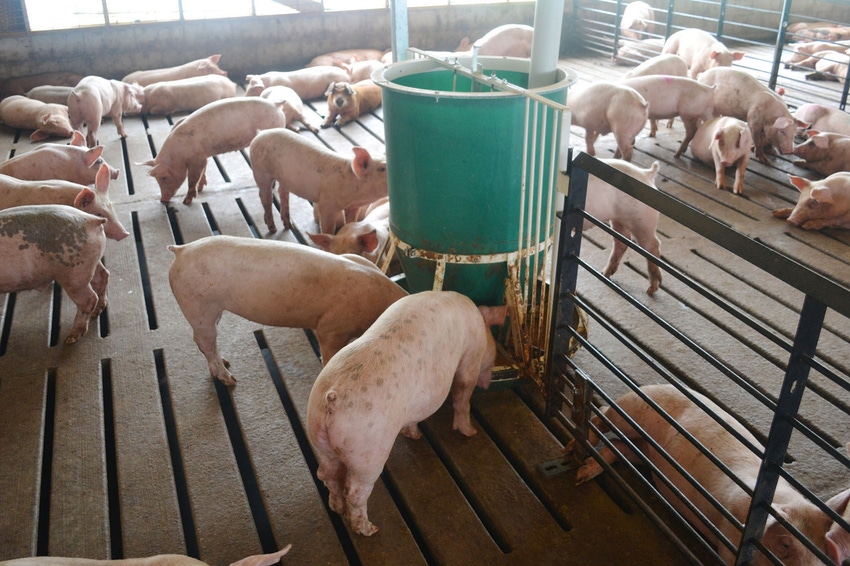Checking feeder pan coverage and for any wastage daily should be a high priority during the growing and finishing phase.
November 16, 2022

It is easy to say we need to lower feed costs in this economic environment. Corn, soybean meal and dietary fat are all elevated in price. Pork revenue is near or below breakeven. The levers we must pull in feed formulation and feed program design seem currently limited. Feels like swine nutritionists and pork producers are stuck on what they can do to lower feed costs. Therefore, what can a swine nutritionist and pig producer implement to lower feed costs in today's environment?
Are we stuck with what we can do with our energy strategy?
One way to improve feed costs is to improve feed efficiency. One of the best ways to improve feed efficiency is to increase dietary energy levels. However, are we currently stuck economically with what we can adjust with dietary energy levels?
There are three primary ways we can adjust energy levels in swine diets. The first way is to add dietary fat. With today's fat prices between 70 and 80 cents per pound, adding dietary fat to improve feed efficiency and barn throughput via added gain is off the table.
The second way is to decrease corn micron size. Easy to say, tough to do as well. Most feed mills are unwilling to suddenly replace their current roller or grinder mill. Therefore, with proper adjustments and maintenance, you may only be able to adjust micron size by 25 to 50 microns. In addition, hammer-milled fine-ground corn under 400 microns can cause feed flow issues. One way around this issue is to pellet finer ground corn. However, to have proper lubrication during pelleting most mills require a minimum amount of added dietary fat. Thus, pelleting costs you the mill charge of pelleting and the increased cost of adding dietary fat to ensure that diet can be pelleted well. If pelleting requires a ten-pound of dietary fat addition minimum to decrease corn micron size and to improve feed efficiency. The cost to the pork producer of pelleting is around $13 per ton. That cost of pelleting in most economic scenarios does not equate to a net gain for the pig owner.
The third way to adjust the energy levels of diets is to change DDGS inclusion (fiber levels). While the inclusion of DDGS can always be set to maximum (or minimum) inclusion, most times the inclusion of DDGS is due strictly to the cost relationship between DDGS and corn. So, can swine nutritionists and pig producers adjust the energy levels of swine diets? Yes, however, we are currently stuck with a feeding program with no added dietary fat, using meal-form diets and adjusting DDGS levels based on its cost relationship to corn.
Are we stuck with what we can do with our on-farm feed usage execution?
Regardless of the economic situation, we can always control our feed usage on-farm. In today's economic scenario it should be a key priority. At the sow farm, one extra pound of feed in gestation today costs $17.50 per sow every gestation cycle or $1.57 per weaned pig (assuming an 11-pig weaned average). Thus, it is crucial to eliminate feed wastage. First, it is important to feed each sow to her body condition. Cull thin sows or sows that require more feed than their contemporaries. Reduce nonproductive days.
Next, market non-bred gilts promptly. Before farrowing, multiple studies have shown that limiting and feeding multiple meals can not only reduce stillborns but can additionally lower feed costs by ~$4/sow per lactation cycle or $0.36 per weaned pig. During the weaning process, it is key to be selective about which pigs to place on feed.
With feed cost this winter ~$110/pig on a wean-to-finish basis, it is important to not place pigs on feed that will be slow growing or unlikely to be marketed as a Grade 1 pig. Finally, checking feeder pan coverage and for any wastage daily should be a high priority during the growing and finishing phase.
It may feel like swine nutritionists and pork producers are currently stuck on what feed program decisions can be justified in these current economic conditions. However, we should never feel stuck with the impact we can make at the slat level to improve feed usage and wastage from the sow farm to the finisher.
Source: Trey Kellner, who is solely responsible for the information provided, and wholly owns the information. Informa Business Media and all its subsidiaries are not responsible for any of the content contained in this information asset.
You May Also Like



